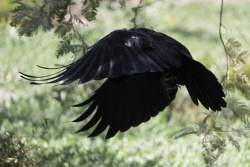Ngala Rig’dzin
This magnificent raven (cha-rog) regularly makes an appearance at Ngala Rig’dzin Dorje and Tsal’gyür Wangmo’s events in Finland and Sweden, where there is a remarkably large and bold raven population. Raven and crow symbolism appears in the attributes of a number of visionary beings in the Aro gTér, and have a plethora of symbolic associations in Vajrayana. They are connected with the presence of the dharma protectors (chökyong and srungma), particularly, being black in colour, with Mahakala and Mahakali. Not all cha-rog have this attribution, only those whose glossy feathers can be seen to possess a blue-green radiance, not dirty, dishevelled or unintelligent birds; ravens being by far the most intelligent of bird species.
Suitable crows and ravens are also the means of a form of auspicy (Mo), which depends on the behaviour of the birds and their number during different sessions of the day and in the various compass directions. A colony of ravens can be seen wheeling and diving above the cave at Yang-le-shöd near Kathmandu where Padmasambhava manifested as Dorje Phurba. Ravens circled around Khandro Déchen and Ngala Rig’dzin Dorje as they sat by a river in Zanskar on the lineage’s pilgrimage in 1992, in front of a mountain whose peak is the dwelling of a manifestation of Mahakala/Mahakali yab-yum. All through the night they were encamped facing the mountain, the Mahakala sadhana practice was audible to some of the pilgrimage participants, being performed in sombre, terrible, awesome tones by the Sambhogakaya beings themselves and their retinue.
Ngak’chang Rinpoche’s first transmission in the West of the sem’dzin of Dzogchen man-ngak-de from the Aro gTér, Ngala Rig’dzin Dorje being one of the recipients, took place on the site of an Iron Age fort atop Hambledon Hill in Dorset, England, in the presence of the local protectors accompanied by a tremendous dawn chorus of crows.
Many crows perch and call out on the rooftops and wheel around Ngala Rig’dzin Dorje’s and Tsal’gyür Wangmo’s house and garden in London, though the trees where their colony is housed is some distance away. According to English legend ravens have a special importance for London. There has been a colony of ravens inhabiting the precincts of the Tower of London for so long that nobody knows in which era this began, and there is a prophesy that unless at least six ravens continue to live there the Tower and the kingdom will fall.
Crows and ravens are accorded great respect by Tibetans because these birds cry out the sound of A, the primordial syllable. The shortest of the Prajnaparamitra sutras, the great excursus on non-duality at the heart of all Buddhism, is the Sutra of A, which consists of one syllable, the syllable A. Cha-rog are regarded as holders of the non-dual teachings, hence the Tibetan proverb that says it is a worse deed to kill one raven than five hundred monks. A is unconstructed, the simplest sound a human being can make, a symbol of the natural state. When a doctor has a wooden stick depressing a patient’s tongue to examine the back of the throat, it is not feasible to formulate Hung or Om, but A, being natural, is always possible. A is the first and last sound of this life. Babies yell A when they are born, and old people sigh A with the final breath leaving the lungs. Ngala Rig’dzin Dorje makes frequent use of the sound of A on retreat events, before and after sessions of meditation practice, and after any passage of mantric melody or Tantric song. The mind rolls out with the sound of the A, the sound lingers in space, and when the sound comes to an end the mind rests in space, coextensive and non-dual with space, realising the natural mandala whose centre is everywhere and circumference nowhere.
